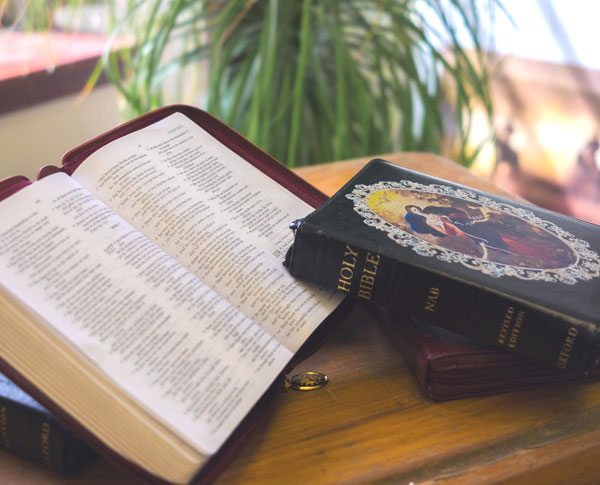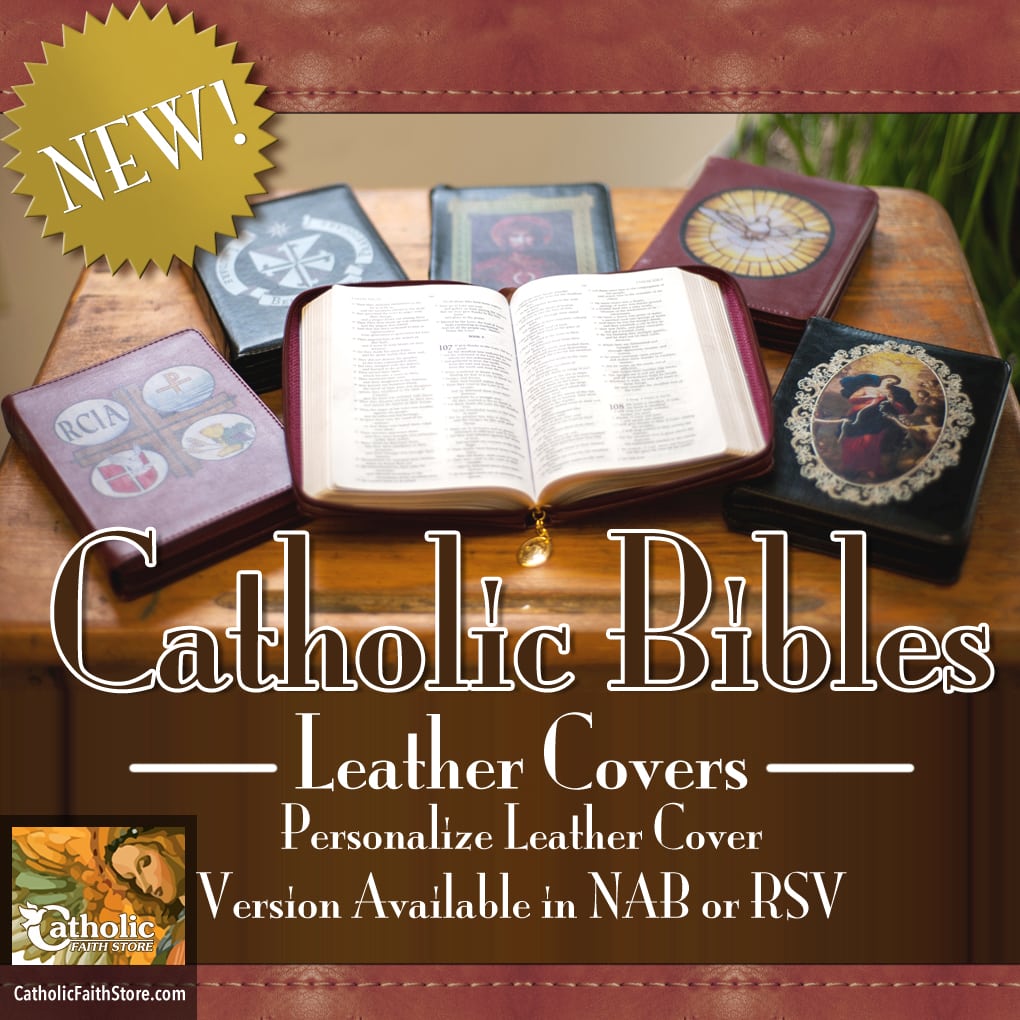Easy to Read and Understand Catholic Bible

What Bible Should A Catholic Use?

"Prayer purifies us, reading instructs us...If a man wants to be always in God's company, he must pray regularly and read regularly. When we pray, we talk to God; when we read, God talks to us."
These are the words of St. Isadore (560-636 AD) on what we gain when we pray and read the Catholic Bible regularly. How many times have you felt alone trying to figure out life's rough patches, or needed words of wisdom and encouragement, or have given up praying because God doesn't seem to answer? Lots of times, right? It's during these moments when you need the Bible the most.
The Bible is God's way of speaking to us telling us, "I am here and am going nowhere. I've got you." It's also a teaching tool that forces us to examine our lives (if we are willing) and ignite in us a desire to change our sinful ways. It may not be easy, but it's the only way to be true children of God.
How do I choose a Catholic Bible?
If you've browsed for a Bible lately, you've noticed that there are several versions (or translations) available. You may be wondering, what's the difference between the versions? Which versions are approved by the Catholic Church? How do I choose the one that's right for me?
The first step in choosing a Bible is making sure you select a Catholic edition. The Catholic Bible consists of 27 books in the New Testament and seven books in the Old Testament: Tobit, Judith, Maccabees 1 and 2, Wisdom, the Wisdom of Ben Sira, and Baruch. Catholic Bibles also include sections in the Books of Esther and Daniel. The Church believes these Old Testament books are part of the canon of Scripture, inspired by the Holy Spirit; they aren't included in Protestant Bibles.
Formal equivalence vs. dynamic equivalence
Once you've found a complete Catholic Bible with all the books from the Old and New Testaments, you have the option of choosing the style of translation that you find most useful. There are two types of translation styles: formal equivalent translation and dynamic equivalent. A formal equivalent translation (also called word-for-word translation) is a more literal version and reads as close as possible to the original (Hebrew, Aramaic, and Greek) language. While extremely accurate, a word-for-word translation can be more difficult to read. In contrast, a dynamic equivalent translation conveys the overall meaning and message of the original, but is in a more readable version. The choice is based on personal preference.
You also have the option of choosing Bibles that have notes, annotations, maps, timelines, and dictionaries to help enrich your reading experience.
Why the need for new translations and revisions of existing translations of the Catholic Bible?
There are several reasons why existing translations need to get revised. One reason is keeping up with the discovery of new ancient manuscripts. When the Dead Sea scrolls were discovered between 1947 and 1956, they contained Biblical and apocryphal works, prayers, and legal texts and sectarian documents that helped scholars better understand the history of Judaism and the beginnings of Christianity. There's also the need to change certain words and idioms that are no longer in use, such as thou, beseech, hearest, etc. into modern vocabulary.
Pope John Paul II spoke of the "three pillars" of good biblical translation: "First, there must be a deep knowledge of the language and the cultural world at the point of origin. Next, there must be a good familiarity with the language and cultural context at the point where the work will arrive. Lastly, to crown the work with success, there must be an adequate mastery of the contents and meaning of what one is translating"—and he praised the translation that "utilizes the vocabulary and idioms of everyday speech."
Which versions of the Bible are Catholic approved?
Two examples of popular Catholic versions are the New American Bible, revised edition (NABRE) and the Revised Standard Version, Catholic edition (RSV-CE)
New American Bible, Revised Edition (NABRE)
Released in 2011, the New American Bible, Revised Edition (NABRE) includes a newly revised translation of the entire Old Testament (including the Book of Psalms) along with the 1986 edition of the New Testament. This edition took nearly 20 years of work by a group of about 100 scholars and theologians.
Revised Standard Version, Catholic Edition (RSV-CE)
The Revised Standard Version, Catholic edition Bible (RSV-CE) is an example of an equivalent translation, or a word-for-word translation. It gives an accurate reading of the Hebrew, Aramaic, and Greek original text and is a strong choice for anyone interested in serious Bible study.
The following is a list of the other translations that have been approved by the United States Conference of Catholic Bishops since 1983.
- Books of the New Testament, Alba House
- Contemporary English Versions:
- New Testament, First Edition, American Bible Society
- Book of Psalms, American Bible Society
- Book of Proverbs, American Bible Society
- The Grail Psalter (Inclusive Language Version), G.I.A. Publications
- The Psalms, Alba House
- The Psalms (New International Version) - St. Joseph Catholic Edition, Catholic Book Publishing Company
- The Psalms - St. Joseph New Catholic Version, Catholic Book Publishing Company
- Revised Psalms of the New American Bible (1991)
- So You May Believe, A Translation of the Four Gospels, Alba House
- Today's English Version, Second Edition, American Bible Society
- Translation for Early Youth, A Translation of the New Testament for Children, Contemporary English Version, American Bible Society
Make sure your Bible gets worn
It doesn't matter whether you get a word-for-word translated Bible, a less literal translation, or a Bible with maps, notes, or pictures; the choice is yours. What matters most is that you get a Bible and that you read it—all the time.
"The Bible is not for putting in a shelf, but rather for having it at hand. It is for reading it often, every day, either individually or in groups, husband and wife, parents and children; maybe at night, especially on Sundays. That way, the family can move forward with the light and the power of the Word of God!" These are the words of Pope Francis urging all followers of Christ to turn to Sacred Scripture. He goes on to say,
"Sometimes He does not speak. I then feel nothing, only emptiness, emptiness, emptiness….But I remain patiently, and so I wait, reading and praying." - Pope Francis
Did you know?
Only 37% of Americans report reading the Bible once a week or more.
77% of practicing Catholics have a desire to read the Bible more.
86% of practicing Catholics view the Bible as sacred literature.
84% of people prefer to read a print version of the Bible

Sources
You may be interested in these:
Source: https://www.catholicfaithstore.com/daily-bread/catholic-bible/
0 Response to "Easy to Read and Understand Catholic Bible"
Post a Comment